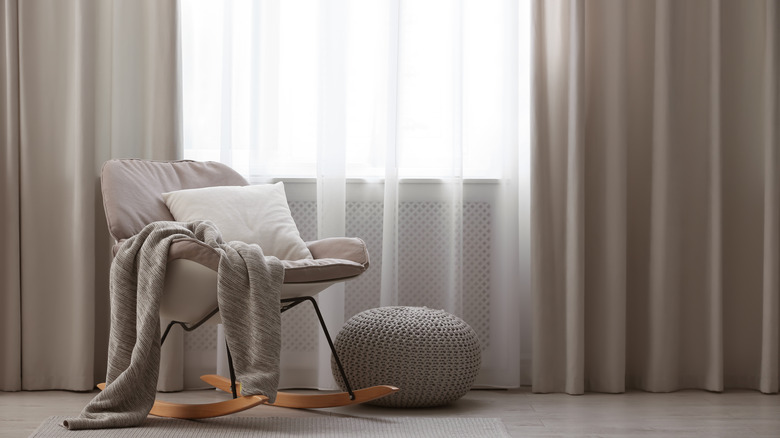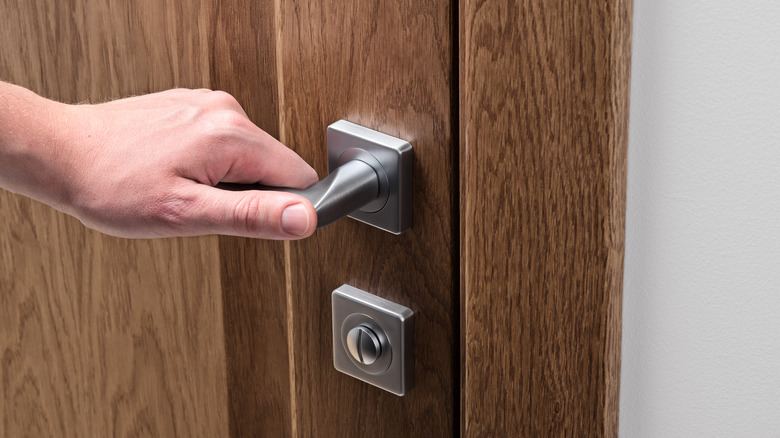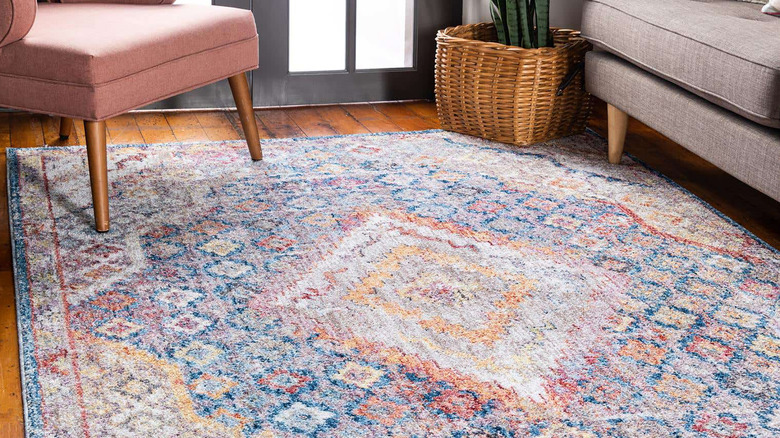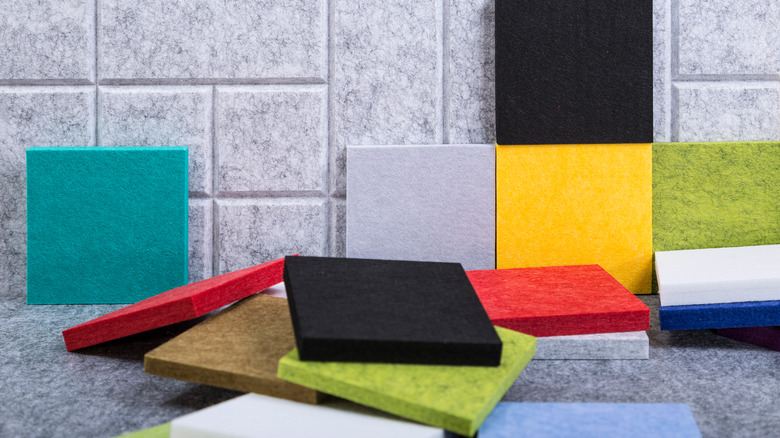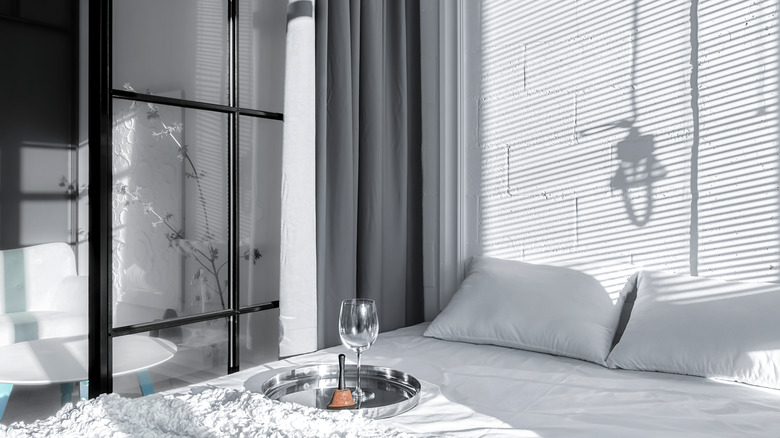8 Ways To Soundproof A Room
Whether you live by a busy road, have your home situated quite close to neighbors or live in an apartment, or simply have several people in your household who all make noise as they go about their day-to-day tasks, there's a good chance that you've had to deal with excessive noise at some point — or, worry about yourself making excessive noise. Depending on the time of day or the noise issue you're dealing with, it can be majorly disruptive, per Verywell Mind.
Luckily, there are quite a few easy ways to soundproof a room. Yes, there are more permanent measures that can be taken if you're renovating or sinking some serious funds into the project, and those can often be the most effective. However, there are also plenty of quick fixes that shouldn't be overlooked, as they can almost immediately improve the issue at hand for a small investment (or even for free, in some cases).
Some people opt to soundproof rooms such as theater rooms, where you really want to keep all that ambient noise at bay. Others might want to soundproof their bedroom so they can get a good night's rest despite living on a busy street. Whatever your particular issues and needs, there's likely a great solution for you — read on to learn about eight different ways you can soundproof your space.
1. Hang noise-reducing curtains
Even if a window is closed, it can often let in a ton of noise; anyone who has ever had a window overlooking a particularly busy street can attest to this. This makes windows a great spot to address when trying to soundproof a space.
Now, if you're looking to invest some serious money in permanent solutions to soundproof a particular space, you can get window inserts or even replace your windows for thicker models that do a better job of blocking sound, as Popular Mechanics suggests. However, if you're looking for an easy, budget-friendly option that you can implement in about 10 minutes, turn your attention to noise-reducing curtains. These are similar to blackout curtains in that they're crafted from quite thick material — no gauzy, semi-sheer curtains here — that is designed to keep noise out. Just be mindful that they'll likely also block out some of the light coming into your space.
When choosing your noise-reducing curtains, Soundproof Living recommends going for curtains that are several inches wider and longer than your window in order to really prevent that sound from entering. You can also potentially double up and hang multiple pairs to make the noise-reducing qualities even more effective.
2. Make some changes to your door
While this isn't the most budget-friendly option out there, it's certainly preferable to taking your room down to the studs and installing things like different drywall panels, etc. The fact is, many homes or apartments have hollow-core doors that offer very little barrier to sound. A simple swap involves just replacing the door to the room you're looking to soundproof with a solid wood door, as First Impressions Wood Masters explains. As they suggest, if you're not quite sure what kind of door you have, just knock on it — you'll know it's hollow if you hear an echo.
In addition to actually swapping out your door, you might also consider adding rubber weatherstripping to any areas where there are gaps, as per Bob Vila's suggestion. You'd be surprised at the amount of sound that can travel in or out through the seemingly tiny gap that's present at the bottom of most doors.
3. Add area rugs
Area rugs often add a burst of color or texture to a space, and can be an integral part of a room's décor. However, as Soundproof Panda explains, they can also be a fantastic tool for soundproofing your room.
This tip is particularly useful in situations where sound is travelling across floors; for example, a downstairs neighbor in an apartment or family member in your home is complaining that they can hear every step you take when you're doing your at-home cardio exercise class. The rug helps muffle these sounds. It also muffles vibrations and harsh noises, meaning that while you'll still likely be able to hear the sounds, they'll be far less jarring and disruptive. As per The Spruce, toss a density rug pad under the rug you've selected to boost the soundproofing properties even more.
If you already live in a space with carpeting, a rug may not make that big of a difference. But if the room you're looking to soundproof has hardwood or tile flooring, it could be a total game changer.
4. Install acoustic panels
While you may have seen acoustic panels in spaces like recording booths before, they're also readily available for purchase and can be hung just about anywhere you need. Like soft materials such as rugs and carpeting, acoustic panels reduce the noise bouncing around, and they can also serve double duty as something that prevents noise from entering, as The Spruce explains.
The major benefit with acoustic panels is that they're light enough to go just about anywhere. Take a moment to examine where exactly most of the noise that's bothering you is filtering into your space, and consider installing a few acoustic panels to combat it. You can place them along a wall, at the back of a closet, by a door, near a window, the options are truly limitless.
And, while there are plenty of old-school panels that may look a bit more industrial than you want for your home, don't worry — plenty of companies make chic, decorative soundproofing tiles or panels that will look fantastic in your space.
5. Strategically rearrange your furniture
If you're looking to soundproof your room without buying a single additional item, even relatively inexpensive ones like curtains, there's a solution: Evaluate your room and see whether you might be able to rearrange your furniture in some way.
As Soundproof Living explains, anything with some serious mass to it can help block or reduce the noise coming in and out of your room, and this includes furniture. So, for example, if there's a shared wall in your room with a noisy neighbor or roommate on the other side, you can try placing a few pieces of furniture like bookshelves along that wall.
Alternatively, if there's a particular spot that seems to get a lot of noise, you can try moving some of your softer furnishings like a sofa or armchair to that spot to help absorb some of that sound. That way it won't bounce off soft furnishings the same way it bounces off wood and other hard materials.
6. Consider room dividing curtains
As discussed, noise-reducing curtains can be a great solution to blocking sound that's coming in from a source like a window or door. However, if you're looking to further reduce the noise and stop it from bouncing around your space, there's another great tip from Soundproof Living: add some room dividing curtains.
Now, this might not be the right solution for a small bedroom, for example. However, if you live in an apartment or space with a very open floor plan, it can be a total lifesaver.
The method for hanging curtains will depend on the look you like, and on what's structurally available in the space, but the overall purpose is to "reduce the total surface area sound waves could bounce off of," as Soundproof Living explains. While regular curtains might achieve this to some degree, this is another scenario where you want thick, noise-reducing curtains to really get the job done.
7. Grab a few blankets
Individuals looking to soundproof a space are in all sorts of scenarios. Some may be looking for a more permanent solution that plagues their home, while others are just looking for a temporary fix. If you fall in the latter camp — for example, perhaps there's a festival going on and there will be music blasting into the wee hours of the night for just one weekend — a great solution from Soundproof Panda is to use blankets.
For best results, you'll want to use the thickest blankets you can find, not that super thin throw blanket that you keep on your couch for decorative purposes. Then, simply hang or place the blankets in the areas where the noise seems to be coming in or vibrating — for example, shoving one along the gap in a door, or hanging it over the window.
Covering up your windows with blankets or having rolled up blankets strewn around your space may not be ideal for a permanent situation, but for a temporary fix, it's an easy and inexpensive solution.
8. Add an extra layer to the window
Making major changes to your windows, such as installing a double pane window, can be seriously expensive, and you may not be bothered enough by the noise to make that investment. However, apart from curtains, there are a few other things you can do to block noise coming in from your windows.
One solution outlined by Soundproof Guide is to add another layer to your window — and no, we're not talking of an opaque material that will block all light from entering your space. A simple layer of acrylic over the window won't change the appearance or the light flowing into the room, but it will help block some of the noise. However, this works best when combined with things like noise-reducing curtains, as the thin panel on its own won't make a dramatic change. Still, you'd be surprised how the little tweaks to your space add up when it comes to quieting down your room.

